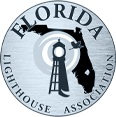The first Mosquito Inlet Lighthouse built by the United States was located on a dune southside of what is considered by many to still be the most treacherous inlet on the East Coast of the country. An entire French Fleet was wrecked there in 1556 during a storm in and near the inlet. Dangerous. Narrow. Tidal rushes of water. A bar at the mouth just waiting for ships to try and cross. Serpentine, shifting sands change the inlet shoreline and its channel almost daily. Sand bars build up in the space of hours.
When Great Britain gained the territory of East Florida in 1763 as a result of the Treaty of Paris which ended the French and Indian War, large and successful plantations settled in the area and commerce became profitable. So much so, that the British colonial government established a “beacon” at the inlet there in 1774. More than likely, it was a nightly bonfire on the north beach. Sometimes, the British also used raised metal baskets with wood set ablaze at dusk, signaling the position of the inlet to maritime commerce. Ships would drop anchor and await daylight and a favorable tide.
After the Revolutionary War, Florida became a territory of the United States in 1821. Eventually, the plantations in the area revitalized, commerce and political pressure steadily increased, and the need for a lighthouse at the inlet was acknowledged by the government. Even with pressure, it took twelve years before Congress appropriated the money for such a structure. A light station was established, constructed and finished during the winter of 1834, but not yet lit in the early spring of 1835 as the oil for the lamps was not delivered. Both the tower and keeper’s residence were erected on multi-acre parcel of government land on the south side of the inlet. The new light station was constructed by the well-known lighthouse builder Winslow Lewis on a site selected by US Inspector of Customs David R. Dunham. Winslow Lewis was the preferred contractor of 5th Auditor of the Treasury Stephen Pleasonton, the government bureaucrat and renowned spendthrift who was in charge of the US Light-House Establishment at that time. Neither Pleasonton nor Lewis knew much about the principles of construction or, for that matter, construction of nautical navigation devices. It was the first lighthouse at what we presently call the Ponce de Leon Inlet.
Mosquito County 1834
As an aside: The 1927 name change from Mosquito Inlet to Ponce Inlet honors Spanish Explorer Ponce DeLeon, who has been dubbed the “Discoverer of Florida.” Folklore says he was looking for the legendary Fountain of Youth. What he really was looking for, like most other European explorers, was land to claim as territories for the mother country, Spain; and of course, gold, silver and slaves. Sailing from Puerto Rico northwesterly, Ponce arrived at what he initially thought was a large island. Since his arrival coincided with the Catholic Holy Season of Easter, he christened the “island,” La Florida, or the Isle of Flowers. Oh, by the way, the official 1927 inlet name change from Mosquito Inlet to Ponce Inlet was less to honor DeLeon and more to placate concerned real estate investors in 1920’s Real Estate Booming Florida. You can just see the ads touting, “Your castle by the sea in beautiful Mosquito Inlet, Florida.” The official name changes from Mosquito County, Mosquito Inlet, etc., will be the subject of another blog.
That first 1835 Mosquito Inlet light was a 45-foot conical structure built of hard brick. The tower featured a 22-foot diameter base tapering to a 10 ½-foot diameter at the top. The walls were three and a half feet thick at the base, graduating to two feet thick at the upper level below the lantern. The outside of the tower was plastered with cement with a wooden door at the base with four panels; and three windows, each with 12 panes of 8 x 10-inch glass. A central spiral staircase was specified to be wood and rising to within six feet of the lantern room at the top of the tower where entrance to the lantern would be via a ladder. The lantern room was fabricated from wrought iron, octagonal in form, and it sat on a soapstone deck four inches thick and 12 feet in diameter.
Artist rendition of the 1835 Mosquito Inlet Lighthouse
The appointed keeper was William H. Williams, the stepson of a prominent local plantation owner and politician. He and his family moved into the light keeper’s residence. Oil, for the lighthouse lamps was not delivered, so Williams was unable to light the lamps. With trouble with the local Seminoles brewing, Williams wisely removed the silver reflectors for the lamps and stored them in a trunk in the keeper’s house.
In October of 1835, the most serious of storms of that stormy year struck, and it completely washed away the 12-foot by 24-foot keeper’s residence. Williams and his family were homeless and forced to move back to his family’s plantation.
It just continued to get worse. As a result of the storm, the tower began to lean. As a rule, Lewis’ light stations and especially its towers, were shoddy and poorly built. Many Lewis lights which lasted over the years have shown that they had no foundations. At the time they were built, and before, there was no national or local governmental agency to inspect and or supervise buildings. In construction of lighthouses the collector of customs was the local official to fire/hire and inspect work. Generally, he was a politician, not schooled in engineering, and certainly not in lighthouse design and construction.
Winslow Lewis
The Lighthouse Establishment in Washington, DC was long-time managed by an underling official of the Federal Treasury Department, Stephen Pleasanton, who knew next to nothing about navigation or engineering, but ran his office pledging that his chief responsibility was saving money. That’s gratifying for most public servants, but Pleasanton’s ignorance of the basics of construction of any kind, engineering and unwillingness to accept any and all advances in technology, put all sailors and passengers’ lives in jeopardy. For Pleasonton, it was all about cost, and the cheaper, the better.
Three justifications for this statement come to mind. Pleasonton, for fiscal reasons, ruled that in his established standards for height of lighthouses to be built, the tallest was limited to be 65 feet. This minimized a tower’s ability to be seen out-to-sea on a curved earth. His second fault was rejecting the superiority of the Fresnel Lens, in favor of the continued use of the obsolete, but less costly, Lewis Lamp, named after the third reason, former ship’s captain, Winslow Lewis. Pleasanton’s reliance on and use of Lewis as his go-to-contractor set American navigational progress and safety back years.
The trunk holding the hidden reflectors seemingly was lost. Williams and his family abandoned the area and went back to his stepfather’s plantation. Two months later, Seminole Indian attacks throughout Northern Florida signaled the beginning of what was later called The Second Seminole War. In fact, in December that year, a Seminole war party attacked homes and settlements along the Halifax and Indian rivers. A standout attractive target was the forty-five-foot tower. The Seminoles attacked the leaning lighthouse tower. They broke the remaining glass, burned the wooden door and set fire to the wooden steps. Because of the increase in areawide Native American uprising and hostilities, the Mosquito Inlet’s white population was forced to leave the area under fear of death. The leaning lighthouse was unable to be repaired, and it finally toppled into the sea, a victim to a Nor’easter in April of 1836.
Artist rendition of the collapsed tower in 1836
On a less serious, but equally fashion-worthy note, Coacocchee, A.K.A, Wildcat, leader of the Seminole band that attacked the 1835 lighthouse, was reportedly seen later in battle wearing one of the lighthouse reflectors which must have washed up from the Williams trunk they were stored in. I can’t think of any other act in battle so fool hearty. Hello musket ball. Aim for the shiny reflection.
Artist rendition of Coacoochee
Despite continuing and on-going monumental increases in maritime shipping and commerce along the Coast of East Florida, and the 100-mile-long unlighted stretch of “dark coast” (no lighthouse beacon) between the St. Augustine Lighthouse and the Cape Canaveral Lighthouse, it would take more than fifty years to decide to design and build the present Mosquito/now Ponce Inlet Lighthouse. Construction began in 1884, and the tower was first lit on November 1, 1887. The station is now a National Historic Landmark and is acknowledged nationally as the best example of a complete, large light station.
Ponce Inlet Lighthouse and Museum



